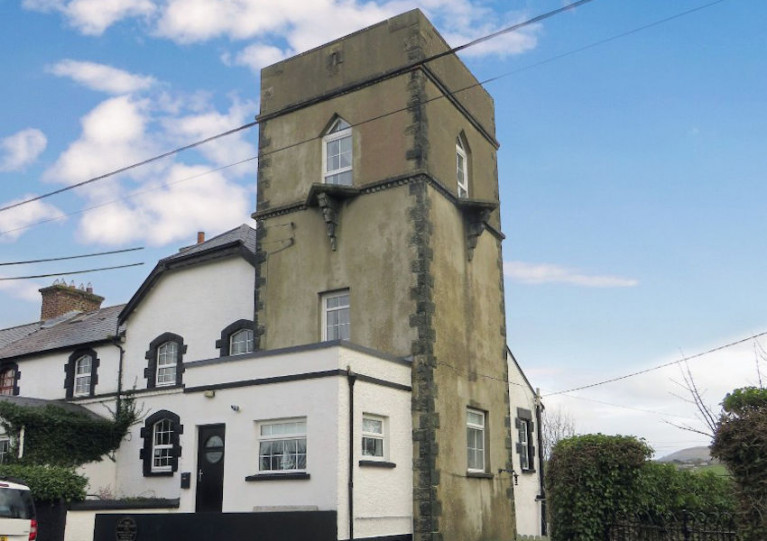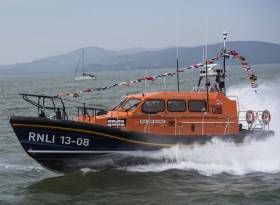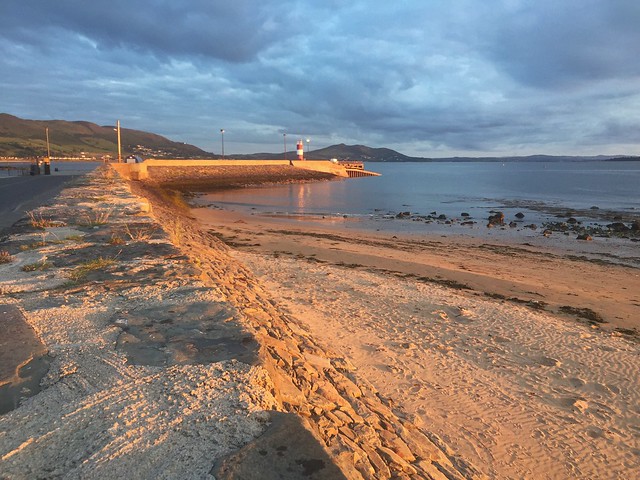Displaying items by tag: Buncrana
Buncrana’s Landmark Former Coastguard Station Up for Sale
Offers of over €200,000 are being sought for the landmark former coastguard station in Buncrana which is now on the market.
As the Derry Journal reports, the building dates from around 1870 and served as the Co Donegal town’s coastguard station between 1880 and 1923.
It continues to enjoy a towering presence in the area, with views over Buncrana Harbour, Mill River and Lough Scilly.
“The accommodation is well proportioned with high ceilings, Oriel windows and deep window seats which create plenty of character,” McLernon Estate Agents say.
Driver Three Times Over Legal Alcohol Limit In Buncrana Pier Tragedy, Inquest Hears
#Buncrana - An inquest into the Buncrana slipway tragedy of March 2016 has found that the driver of the car that slipped into Lough Swilly was more than three times over the drink-driving limit.
As previously reported on Afloat.ie, five people died after their car slipped into the water from a pier in Buncrana, Co Donegal on Sunday 20 March.
Sean McGrotty (49) was driving the car with his sons Mark (12) and Evan (8), his baby daughter Rioghnach-Ann, the children’s grandmother Ruth Daniels (59) and her daughter Jodi-Lee (14), according to The Irish Times.
Only Rioghnach-Ann was rescued from the car, thanks to the quick actions of local GAA player Davitt Walsh — who received a silver medal in the 2016 National Bravery Awards for his efforts.
Walsh told the inquest of his difficulties in getting back up the slipway from the water due to its coating of algae, noting that its slipperiness might not be obvious to people unfamiliar with the area.
Local man Francis Crawford also spoke at the inquest, recounting how he called to McGrotty has he saw the car slowly entering into the water at the bottom of the slipway, which was “slippery as ice” with algae.
“I was hoping that the emergency services would arrive and the car would not go down,” he said, adding that he believed it had been in the water for around 12 minutes before it sank.
McGrotty’s partner Louise James, who was away at the time of the incident, said through her solicitor: “I firmly believe the slipway should have been closed to the public or else proper warning signs displayed. It was an accident waiting to happen.”
The Irish Times has much more on the story HERE.
#RNLI - Arklow man and former lifeboat operations manager Jimmy Tyrrell will have the honour of naming the first class of RNLI lifeboat to be named after an Irish river this Saturday 25 June in Buncrana, Co Donegal.
Lough Swilly RNLI will hold the special naming ceremony and service of dedication from 11.30am to officially name the first Shannon-class lifeboat in Ireland, Derek Bullivant.
The Donegal lifeboat station was the first in Ireland to receive the new €2.4 million lifeboat, which is the most modern and technically advanced lifeboat in the RNLI fleet.
Shortly after its arrival on station, the lifeboat brought three local fishermen to safety after they had been reported missing when their vessel had lost power and drifted out to sea.
The lifeboat was funded by legacies from Derek Bullivant and Valerie Walker. Bullivant was born in Birmingham in 1922 and was a trained chemist before working as an industrial analyst for a company in the metal industry. He went on to start his own company which became one of the biggest aluminium recycling companies in the UK. He always wanted his success to benefit lifesaving and humanitarian charities which led him to provide a generous legacy which helped to fund the Lough Swilly lifeboat.
The second legacy was bequeathed from Valerie Walker from Portsmouth. Walker was a supporter of the RNLI and her legacy has been used to part fund the lifeboat. Her generosity will be remembered and acknowledged by a plaque which will be placed in the boathouse at Lough Swilly lifeboat station.
The Shannon is first class of lifeboat to be propelled by water jets instead of traditional propellers, making it the most agile and manoeuvrable all-weather lifeboat in the fleet.
Waterjets allow the vessel to operate in shallow waters and be intentionally beached. The lifeboat has a top speed of 25 knots and a range of 250 nautical miles, which makes it ideal for offshore searches and rescues in calm and rough seas.
The new lifeboat was developed to operate in the worst of sea conditions and is self-righting, automatically turning the right side up in the event of a capsize. Its unique hull is designed to minimise slamming of the boat in heavy seas and the shock-absorbing seats further protect the crew from impact when powering through the waves.
Commenting on the forthcoming occasion, Lough Swilly RNLI lifeboat operations manager John McCarter said: "Many people will know that we welcomed the lifeboat to Buncrana a little over a year ago but in grand RNLI tradition we officially name and dedicate the lifeboat after that and in doing so remember our generous benefactors who through their legacies have provided this incredible gift to our community.
"We are delighted that Jimmy Tyrrell will be officially naming our lifeboat. Our colleagues in the lifeboat community will know that Jimmy lobbied the RNLI for years to have a class of lifeboat named in recognition of the role Ireland and Irish lifeboat volunteers have played in the work of the charity for 192 years. All other lifeboat classes are named after UK rivers so the Shannon is truly an Irish lifeboat."
The Shannon lifeboat also has another strong Irish connection. Peter Eyre, an RNLI engineer from Derry who works at the charity’s headquarters in Poole, was instrumental in the development of the new lifeboat, designing the hull form at the age of 24.
The first all-weather lifeboat put on service in Lough Swilly was The Good Shepard in 2000.
Galway Blocks Docks Slipway After Buncrana Tragedy
#Galway - Galway Harbour Company has blocked open access to a slipway in Galway Docks weeks after the Buncrana tragedy, as the Connacht Tribune reports.
The move was made a month after five members of the same family, including three children, died after their car slipped into Lough Swilly from the open slipway at Buncrana, Co Donegal on Sunday 20 March.
Galway's docks slipway had been used freely by recreational boaters – but as of last Thursday (21 April) local sailing clubs have been informed that the slipway can only be used with permission.
Access times have also been restricted to 9am-5pm on weekdays and by appointment on Saturdays in what the harbour company says is a move to avoid "risk to life".
But one local user has branded the locking-up of the slipway as "ridiculous" and said "there should have been a more measured response and consultation".
The Connacht Tribune has much more on the story HERE.
Five Dead After Family Car Plunges Off Donegal Pier
#Buncrana - Five people, including three children, understood to be from the same family are dead after their car slipped into the water at Buncrana, Co Donegal last night (Sunday 20 March).
As the News Letter reports, a major emergency operation was launched after the Northern Ireland-registered estate car went off a pier into Lough Swilly after 7pm.
The bodies of two adults and three primary-aged children were recovered shortly after.
A baby who was also in the car is believed to have been thrown or handed out of the vehicle before it went into the water.
The cause of the tragedy is not yet known but it's understood that the surface of the pier slipway may have been slippery with algae.
The News Letter has more on the story HERE.
Buncrana Brings Back Seafront Diving Boards to Revive Its Past
#COASTAL NOTES - The Belfast Telegraph reports that one Co Donegal seaside town is returning to its past in an effort to attract more visitors.
Buncrana is set to bring back the diving boards that once lined its shorefront some three decades after they were removed, in what the town's mayor says is a move to promote tourism as well as healthier outdoor activities among young people.
Mayor Nicholas Crossan commented to the Irish News: “I remember as a youngster we used to play football on the shorefront and then when the tide came in we’d be down to the diving boards and into the water to cool off. It was the greatest fun."
The Belfast Telegraph has a gallery of images of Buncrana and the Inishowen Peninsula in yesteryears HERE.
Donegal Ferry Services Under Review
The cross-border service is funded by Donegal County Council and Limavady Borough Council. The route in recent years has experienced an unfavourable exchange rate, increased cost of fuel, poor weather, a depressed tourism market sector and notably reduced construction traffic, contributing to a sharp decline in demand. In the current climate the local authorities may find it difficult to provide funding as they scale back on budgets.
Record levels in 2005/2006 saw traffic reach 106,179 vehicles and 302,740 passengers. Such was the success of the service annual subsidies for 2008 and 2009 were not required. According to the latest 12-monthly traffic figures for June 2009-June 2010, vehicle volumes dropped to 52,669 and passengers levels have decreased more than halve to 149,455.
The 10-minute route is operated by the 44-vehicle capacity Foyle Venture which served the Kilimer-Tarbert route for the Shannon Ferry Co. The mid-west estuary ferry was replaced by newbuild Shannon Breeze in 2000 and later sold to Lough Foyle Ferry Co.
When the Lough Foyle route began operations in 2002, the service received a subvention of €108,000 each from the local councils. Over that timeframe, the route has received a total funding of €500,000 from Donegal County Council.
In 2009, the two local authorities agreed to provide a €200,000 subvention, but this runs out in March 2011. An application has also been submitted to the Special EU Programmes Body for funding.
On the west side of the Inishowen Peninsula is the Bunbcrana-Rathmullan service, which is also in doubt if a subsidy from Donegal County Council cannot be maintained. The Lough Swilly route started in 2004 and is served by the 20-vehicle capacity Foyle Rambler, a former German river-ferry. The north-west ferry route takes 25-minutes and recorded 15,000 passengers at its peak.
In busier times, tourists from the North, instead of passing through Derry city, used the 'land-bridge' routes across the Inishowen Peninsula to reach holiday-homes and popular seaside resorts throughout Co. Donegal.





































































